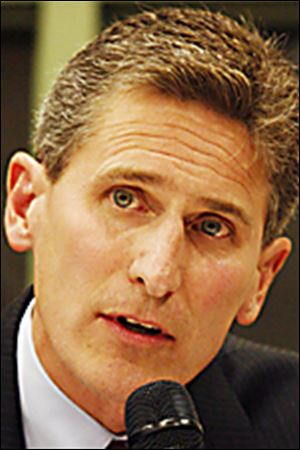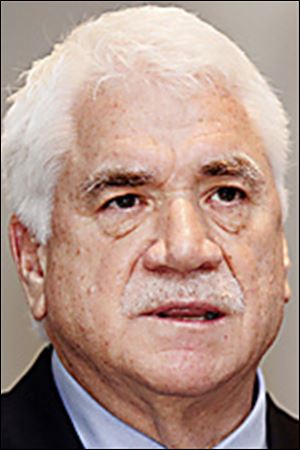
Kasich school plan prompts optimism for area educators
2/2/2013
Ohio Gov. John Kasich leaves the podium as he speaks at a special meeting of the Buckeye Association of School Administrators on Thursday in Columbus.
ASSOCIATED PRESS
COLUMBUS — Ohio school superintendents reacted with guarded optimism Thursday to Gov. John Kasich’s school funding proposal, as they hailed a guarantee that no school districts will receive less money under the plan than they currently do, but must wait for details on how the formula would affect individual districts.

Ohio Gov. John Kasich leaves the podium as he speaks at a special meeting of the Buckeye Association of School Administrators on Thursday in Columbus.
The governor’s proposal targets more aid for poorer school districts, expands funding for charter schools and access to vouchers to attend private schools, and dangles $300 million in one-time carrots before districts that innovatively break the public education mold.

Rieger
“No one is going to lose under this proposal,” Mr. Kasich said.

Pecko
Basic aid to schools would increase 6 percent in the first year of the two-year budget and 3.2 percent in the second. Toledo Public Schools Superintendent Jerome Pecko called the new funding formula “innovative,” and said it appeared the proposal would help districts such as TPS that have high poverty, low property values, and high rates of students with disabilities.
“It gives us a little bit more of the total pot of the revenue that’s being divided up among all of our school districts,” he said, “and that’s good news.”
The Ohio Supreme Court has repeatedly ruled that the state’s heavy reliance on local real-estate taxes to fund schools unconstitutionally places students in property-poor districts at a disadvantage compared with wealthier counterparts.
The plan unveiled Thursday would take into consideration the amount of revenue each school district generates from a single mill of property taxation as well as district residents’ income levels. It assumes that all school districts have $250,000 of property value for each student — a level only 24 districts now exceed — then provides state aid to compensate those whose actual valuations are less.
Ohio schools now are required to levy at least 20 mills of property tax, which can raise anywhere from $900 to $14,000 per student depending on district wealth.
“That’s a huge disparity,” said Barbara Matteri-Smith, assistant state policy director for education. “A lot of our effort reduces that disparity to ensure all students have equal opportunities for success.”
One mill equals $1 of tax for each $1,000 of assessed property value.
The second half of the poverty factor provides additional aid to school districts whose average family income is in the lower four-fifths of all Ohio districts.
Matt Cleland, the Toledo schools’ treasurer, said low-income districts appear to be acknowledged in the budget proposal. He said he was encouraged by the funding guarantee for the next two years, but is concerned the guarantee may eventually be phased out.
“We are eager to see the estimates for each district that are expected out next week,” he said.
Superintendents won’t know until the middle of next week how the formula will affect individual districts’ funding, but the pledge that no district will lose funding was a relief to Perrysburg Superintendent Tom Hosler.
He said the plan left him feeling positive but still guarded, because state leaders in the past have promised funding streams only to take them away later, citing the Ohio Lottery as an example. While lottery funds technically still go to Ohio schools, other state education funding has been cut in recent years.
“If we were grading the governor, I think the grade will be incomplete, and we need to have him show his work,” Mr. Hosler said.
Anthony Wayne Superintendent Jim Fritz and Sylvania’s Brad Rieger said the proposal’s details won’t be known until at least next week.
School leaders took part in a presentation about the formula Thursday with Mr. Kasich and state education leaders. The plan’s provision of full funding of all-day kindergarten was one of few lines during Mr. Kasich’s presentation that drew the superintendents’ applause.
And Mr. Kasich warned that guaranteeing that none of Ohio’s 613 school districts will get less state money from one year to the next is, in the long term, unsustainable.
“We have over 400 districts on guarantees. That’s politics.” he said. “We are now providing resources to schools when they have a shrinking student population, and yet you’re depriving schools that may have a growing population ... because we haven’t frankly targeted where those resources ought to flow.”
The proposal will now go through the legislative process, which could take months. State Sen. Randy Gardner (R., Bowling Green), chairman of the Senate finance subcommittee on education and a former teacher, called the proposal a “meaningful funding commitment for education.”
“It is clear that the governor listened carefully to educators across the state to address some concerns that school leaders have faced for a long time,” Mr. Gardner said in a statement.
While the plan does not cut basic subsidies to schools, neither does it provide the restorative funding sought by Democrats to undo severe cuts schools sustained during the current two-year budget.
Mr. Kasich has technically boasted that his administration increased state basic aid in 2012 and 2013, but schools still suffered major pain from the simultaneous loss of one-time federal “stimulus” dollars paid out during the recent recession and by the state’s accelerated weaning of schools off revenue from a pair of canceled business taxes.
“I don’t see the relief from the challenges that school districts are facing right now,” said State Rep. Teresa Fedor (D., Toledo), ranking Democrat on the House Education Committee and a former teacher. “I like some of the concepts. I think they are good concepts, but I don’t think it takes care of what districts need at this time.”
In his second budget proposal, Mr. Kasich has offered additional funds for schools to help implement a new law prohibiting the promotion of third graders who still haven’t mastered reading, and assigns extra aid to districts with large numbers of students who have special needs or disabilities, or who are learning English as a second language. It also aims support toward programs for gifted students and high school students taking college-level courses.
In all, the amount of state funds funneled through the new basic aid for schools would be $6.2 billion in fiscal year 2014, beginning July 1, and $6.4 billion the following budget year. Total general revenue spending after factoring in extras such as the proposed $300 million “Straight A” fund would be $7.4 billion and $7.7 billion, respectively.
Befitting a plan rolled out during National School Choice Week, Mr. Kasich’s proposal would expand the number of students who could apply for state-funded scholarships, or vouchers, to attend the public, private, or religious schools of their parents’ choice.
Currently, Ohio’s Ed Choice program offers up to 60,000 such scholarships to children who attend schools that consistently score poorly in state assessments, but the program has so far been dramatically underutilized.
Mr. Kasich’s budget proposal would include any student entering kindergarten at any school whose family income is double the federal poverty level. It would add first graders the second year.
Charter schools would receive state aid, $100 per student, for the first time for their own facility needs. Charter schools may not pass their own property taxes to support facility-improvement bonds.
Martin Porter, director of the Toledo School for the Arts, said the lack of facilities funding has been a significant challenge for charter schools. His school spent about $670,000 last fiscal year on occupancy costs; the new funding would cover about a tenth of that for his school.
“While I’m sure we could use a lot more money,” he said, “I think the gesture is really wonderful.”
Appearing to take a page from President Obama’s Race to the Top program, which dangled cash in front of schools that adopted certain reforms, Mr. Kasich is proposing a $300 million “Straight A” fund for which districts would compete for one-time grants for efforts that would improve education, increase efficiency, and ultimately save money.
Local districts, however, would be financially responsible for supporting those new programs going forward.
Contact Jim Provance at:
jprovance@theblade.com
or 614-221-0496.